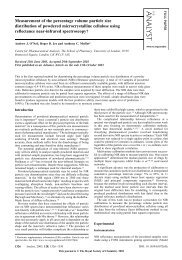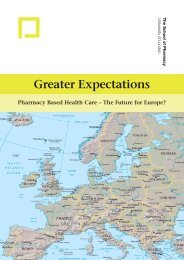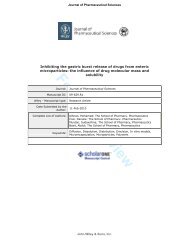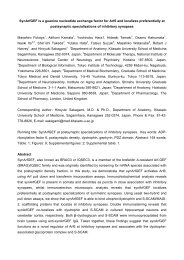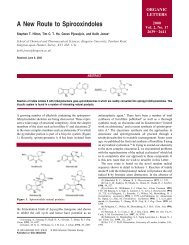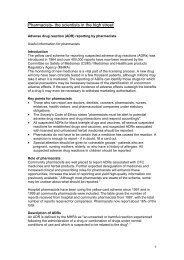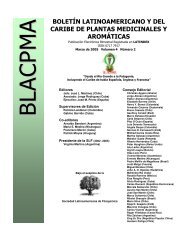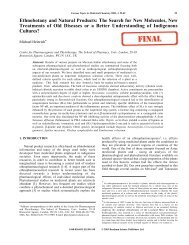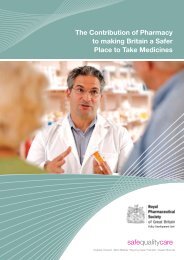Inhaler technique in Turkish people with poor English: a case of ...
Inhaler technique in Turkish people with poor English: a case of ...
Inhaler technique in Turkish people with poor English: a case of ...
Create successful ePaper yourself
Turn your PDF publications into a flip-book with our unique Google optimized e-Paper software.
Pharm World Sci (2006) 28:107–114 113<br />
Both <strong>in</strong>formation methods resulted <strong>in</strong> small but<br />
statistically significant improvements <strong>in</strong> some<br />
<strong>in</strong>dividual <strong>technique</strong> steps, although co-ord<strong>in</strong>ation,<br />
the most important aspect <strong>of</strong> <strong>technique</strong>, was only<br />
improved <strong>in</strong> a small number <strong>of</strong> <strong>people</strong>.<br />
Conclusions<br />
There were demographic differences between our<br />
two language groups, and this is an acknowledged<br />
weakness <strong>in</strong> this study. However, we do not<br />
believe that these differences alone expla<strong>in</strong> why<br />
<strong>in</strong>haler <strong>technique</strong> <strong>in</strong> the <strong>people</strong> <strong>with</strong> <strong>poor</strong> <strong>English</strong><br />
was so much worse than <strong>in</strong> the FE users <strong>of</strong> the<br />
same <strong>in</strong>haler (Ventol<strong>in</strong>). Discrim<strong>in</strong>ation <strong>in</strong> terms<br />
<strong>of</strong> access to the written <strong>in</strong>formation supplied <strong>in</strong>side<br />
every <strong>in</strong>haler pack also needs to be considered.<br />
The <strong>in</strong>terventions we tested suggested that a<br />
translated PIL, used alone, is <strong>of</strong> less benefit than<br />
the same leaflet used together <strong>with</strong> own-language<br />
verbal advice. This supports others [3, 16] who<br />
have concluded that it is simplistic to propose that<br />
written translation alone is the answer to the<br />
language barrier when provid<strong>in</strong>g medic<strong>in</strong>es<br />
<strong>in</strong>formation. The <strong>Turkish</strong> <strong>in</strong>haler-users <strong>in</strong> our<br />
study were mostly literate <strong>in</strong> their mother tongue<br />
but the assumption that if you can speak a language<br />
then you can read it is not necessarily<br />
true[13], either for native <strong>English</strong> speakers or for<br />
foreigners.<br />
A broad portfolio <strong>of</strong> methods, <strong>in</strong>clud<strong>in</strong>g pictograms,<br />
audiotapes and computer and web-based<br />
multimedia (available through term<strong>in</strong>als <strong>in</strong> surgeries,<br />
pharmacies and other public <strong>in</strong>formation<br />
po<strong>in</strong>ts) needs to be developed if all patients are to<br />
Table 7 Categorical <strong>technique</strong> variables (paired data; sign test)<br />
Technique<br />
measure<br />
Checks mouthpiece<br />
(n correct)<br />
Shakes <strong>in</strong>haler<br />
(n correct)<br />
Co-ord<strong>in</strong>ation<br />
(n correct)<br />
Multimedia group Leaflet + translator group<br />
N <strong>case</strong>s Before<br />
<strong>in</strong>fo<br />
After<br />
MTS<br />
P<br />
value<br />
have equal access to good medic<strong>in</strong>es <strong>in</strong>formation.<br />
Lack <strong>of</strong> computer experience need not be a barrier.<br />
The majority <strong>of</strong> <strong>Turkish</strong>-speak<strong>in</strong>g subjects<br />
and elderly <strong>English</strong> subjects had little or no<br />
experience but found the method both easy and<br />
enjoyable.<br />
The ability to <strong>of</strong>fer patients a choice <strong>of</strong> language<br />
makes multimedia systems useful educational<br />
tools but they are not a panacea to the<br />
problem <strong>of</strong> <strong>poor</strong> <strong>in</strong>haler <strong>technique</strong>. Our volunteers<br />
were long-term <strong>in</strong>haler users, <strong>with</strong> deeply<br />
<strong>in</strong>gra<strong>in</strong>ed habits. The impact <strong>of</strong> <strong>in</strong>formation on<br />
their <strong>in</strong>haler <strong>technique</strong> was modest at best, and<br />
co-ord<strong>in</strong>ation did not improve <strong>in</strong> the majority <strong>of</strong><br />
patients tested.<br />
Greater benefits could be expected <strong>in</strong> <strong>people</strong><br />
us<strong>in</strong>g <strong>in</strong>halers for the first time, and a multimedia<br />
touch-screen computer could <strong>of</strong>fer a convenient<br />
alternative to the use <strong>of</strong> a translator for the brief<br />
explanations normally given <strong>in</strong> surgery or pharmacy.<br />
However, the f<strong>in</strong>d<strong>in</strong>gs demonstrate that<br />
<strong>in</strong>formation alone is rarely enough to change<br />
behaviour. To improve <strong>poor</strong> co-ord<strong>in</strong>ation, the<br />
<strong>in</strong>haler user first needs to see and understand<br />
what he is do<strong>in</strong>g wrong, and then to practise until<br />
the correct method becomes automatic. This<br />
learn<strong>in</strong>g process needs practical one-to-one<br />
teach<strong>in</strong>g from someone who can demonstrate<br />
correct MDI <strong>technique</strong>. In our study, the video<br />
camera was a very useful teach<strong>in</strong>g and learn<strong>in</strong>g<br />
tool.<br />
This study suggests that a significant proportion<br />
<strong>of</strong> <strong>in</strong>haler users <strong>with</strong> <strong>poor</strong> <strong>English</strong> may never<br />
attend GP asthma check cl<strong>in</strong>ics, and only visit the<br />
surgery when they become ill. However, all<br />
<strong>in</strong>haler users must present their prescriptions to a<br />
pharmacist. The acceptability and feasibility <strong>of</strong><br />
N <strong>case</strong>s Before<br />
<strong>in</strong>fo<br />
After<br />
PIL<br />
P<br />
value<br />
After PIL +<br />
verbal advice<br />
P<br />
value<br />
34 8 (23%) 16 (47%) 0.05 35 2 (6%) 1 (3%) ns 11 (31%) 0.004<br />
34 16 (47%) 24 (72%) 0.04 35 22 (62%) 16 (46%) ns 35 (100%) 0.001<br />
34 4 (12%) 11 (35%) ns 35 4 (11%) 6 (18%) ns 10 (28%) ns<br />
123



